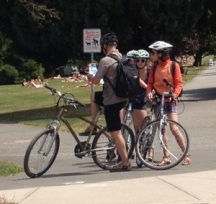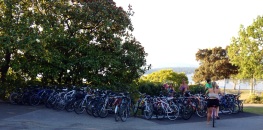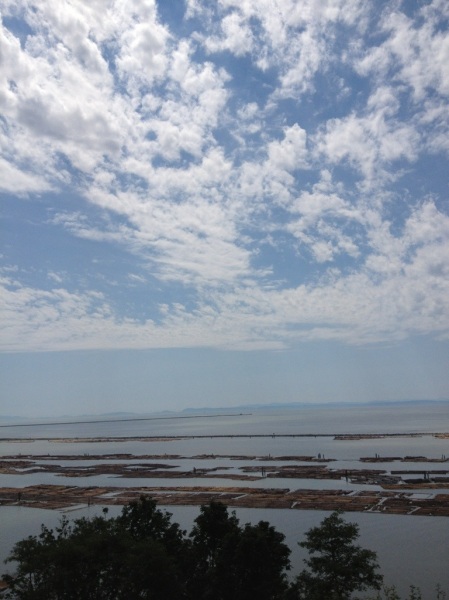The Point Grey Cornwall Greenway, by completing the Seaside Path, will open up the West Side waterfront enabling people of all ages and abilities to enjoy Vancouver’s beautiful scenery by bicycle while giving both locals and visitors access to Kits Beach, Jericho Beach and Spanish Banks.

Further on there is the Museum of Anthropology, UBC Botanical Garden, Nitobe Memorial Garden, Wreck Beach, Pacific Spirit Park and paths along the Fraser River. Hundreds of thousands of residents and tourists cycling along the Greenway will help boost business at restaurants, cafes and stores in Kits.

Vancouver’s $3.7 billion tourism industry is critical to our economy. Vancouver’s new Tourism Plan identifies, Cycling, the Seawall & Beaches and Health/Wellness as part of its recommendation to initiate a product development strategy. The Plan also identifies Public Bike Share as part of the transportation infrastructure needed to support tourism. Cycling tourism in Oregon accounts for $400 million of the state’s $9 billion tourism industry. There is likely similar potential in B.C.
Pretty much every article on what to do when visiting Vancouver, mentions getting on a bike. The most common recommendation is cycling around Stanley Park but more and more are mentioning the separated bike lanes and exploring other parts of the city by bicycle. Judging by the number of people taking photos from the Burrard Bridge and looking at maps along Pt Grey Cornwall, this part of town is getting to be a popular place for visitors to cycle to.
Vancouver, B.C., has idyllic and easy urban biking for all ages | Outdoors | The Seattle Times
Ride the Seawall, a paved route for bicyclists and pedestrians, in the heart of the city.
For adult fun, veer off the path into the trendy Yaletown neighborhood that’s packed with restaurants, coffee shops and bars.
Hungry? Stop for a bite at the trendy Cactus Club, which opened this spring right on the sand at English Bay Beach.
Thinking of a cycling vacation? Ocycler Jeff Mapes has some worldly ideas for you | OregonLive.com
The city has now steadily expanded the bike network to circle the entire West End and two bisecting cycletracks now offer comfortable riding through downtown.
On another day we headed east to Commercial Drive, a lively eating-and-drinking street that reflects the city’s rich immigrant diversity.
Seems like everyone except the businesses that would benefit the most are noticing Vancouver’s cycling tourism potential. Even tourism operators in other city as witnessed by this article More and more travellers taking a spin on bicycle tourism in Montreal.
All the possibilities clearly have Mayer thinking of exporting the bike-tourism concept to other cities in Canada and beyond. … Vancouver is a market that clearly has his interest. “We have better climate, longer seasons,” he said of the coast city.
A recent visitor from Melbourne really said she really liked Vancouver’s bike lanes.
I was dreading the trip through the city but the separated bike lanes on the Burrard Bridge and along Hornby made this part of the trip most enjoyable and I felt safe. Judging by the number of people we saw on bikes poring over a map, this is becoming a popular tourist activity. What a wonderful way to see Vancouver and get some exercise.
Great for Business

Given the economic importance of tourism, it is rather surprising that Pt Grey Cornwall Greenway is not more strongly supported by the Kits Chamber of Commerce and some of the local business that stand the most to gain from more visitors and locals cycling by. Instead of worrying about losing a few parking spaces on Cornwall (which is not even in the current proposal), they should be really upset that the city is attempting to divert all these stomachs on wheels up York away from their businesses.
This is perhaps not entirely unexpected as the City has yet to integrate tourism into its bicycle route planning. In this case, tourism is not featured anywhere in the City’s materials on Cornwall Point Grey.

Businesses Are Taking Advantage of Bike Lanes
When the separated bike lanes come, some businesses look to take advantage of the full advantage opportunity. Jeweliette Jewellery (love the name), on Hornby between Nelson and Helmcken has a pink bike parked in front with flowers in the basket. Owner Madalena Corsi loves having bike lanes in the neighbourhood and says many customers arrive by bicycle.

Musette Caffè is a bicycle friendly cafe that ironically is in the middle of an auto lot on the alley between Hornby and Burrard north of Drake. They serve great coffee and baked goods and are a popular meeting spot for people on bikes.
Bike rental shops are also popping around the Convention Centre up at the north end of the separated bike lanes. Once the Pt Grey Cornwall Greenway is complete, businesses will likely take advantage of that opportunity as well.
Which Way to the Beach?
Unfortunately, it does not appear as if tourists, many local recreational cyclists or beach goers have yet been really considered in the planning process. It is not apparent how people will cycle from Burrard Bridge to Kits Beach and back again. I suspect most will just ride on Cornwall battling the traffic or ride on the sidewalk. Detouring up to York for just two blocks crossing busy Cornwall twice doesn’t seem likely.
Direct Obvious Routes for Visitors
Having got really lost cycling around Paris a couple of times, I can attest to the importances of obvious direct bicycle routes when visiting a city. Signage and maps are great but they are no substitute for obvious. York It is not very likely that tourists will use or even find York. They will also want to grab a snack or have a drink at the businesses along Cornwall.
Burrard Bridge Popular with Visitors and Beach Goers
There are great views of the city, mountains and ocean from Burrard Bridge. It is quite common to see people taking photos from the Bridge sidewalks. Burrard Bridge is a much faster route from hotels downtown to the beaches. The bicycle traffic levels on Burrard also peaks in July and August at almost 6,000 trips per day while Hornby and Dunsmuir are fairly steady from June through September indicating that a lot of beach and recreational trips are made on Burrard. Many sure look like they are going to the beach.
Seaside Path Needs a Lot of Work
The Seaside Path around False Creek from Sunset Beach to Kits Beach also needs tens of millions of dollars in improvements to address safety and capacity issues including creating separate bicycle and pedestrian paths in many sections. Not really a great idea to encourage more people to use these sections until improvements are made. Meanwhile, the Hornby and Burrard Bridge separated bike lanes have plenty of capacity, are separated from pedestrians and with the exception of Burrard and Pacific, have relatively few cycling collisions. Providing a direct cycling connection along Cornwall to Point Grey seems like the least expensive short term solution for cycling tourists.
In Barcelona, shared bikes are a very popular way to get to the beaches. From Granville Station, Kits Beach is a nice quick ride away via Dunsmuir, Hornby, Burrard Bridge.
Bike Sharing Big for Bikes and Businesses
Bike sharing, which will be going in early next year, should prove to be a game changer for bikes and businesses. In other cities, businesses have clamoured to get a station near by. A University of Minnesota study found that bike share users in the Twin Cities make more trips to and spend more money at nearby businesses including restaurants, coffee shops, bars, nightclubs, and grocery stores. When bike sharing does finally appear later this year, businesses, including those along Cornwall, might indeed be wishing they had separated bike lanes in front of them to encourage bicycles, shared and otherwise, to deliver customers to their doors.
Take Action
So, please encourage the City of Vancouver to build the Point Grey Cornwall Greenway now and speed up the implementation of other badly needed all ages and abilities cycling and walking improvements. Lets realize the health, safety, environmental, social and economic benefits of as soon as possible! Tell them the problems that you have experienced along Point Grey & Cornwall and let them know what the Point Grey Cornwall Greenway would mean to you, your family and community.
- Address City Council on July 23. The meeting starts at 2pm. Email meetingcoordinator@vancouver.ca or call Lori Isfeld, at 604.871.6355, by 1 pm on Monday, July 22, 2013. More info…
- Write Mayor Gregor Robertson and Council <mayorandcouncil@vancouver.ca> in support of the Point Grey Cornwall Greenway.
- Write letters to the editor: https://bikehub.ca/media
More on Point Grey Cornwall
- HUB’s Petition
- Pt Grey Plans Safer for Residents Children Walkers Drivers & Cyclists
- Speed Up Building the Bike Network Starting with Pt Grey Cornwall
- Separated All Ages Bike Lanes Needed on Cornwall
- Everyone Will Enjoy $300 Million Pt Grey Views
- Point Grey Road – Cornwall Avenue Greenway | City of Vancouver
Photos around UBC and along the Fraser









Excellent and thorough article, Richard. Yesterday I rode with a group of friends around the Vancouver Shores and along Seaside and we all agree that we would like a safe flat route on Cornwall/Point Grey. We enjoyed eating at a few of the restaurants along the way and see the tourism potential on this corridor. We followed the Seaside signs jogging up and west and then decided to try Point Grey/Cornwall heading back and we agree that It’s time for these improvements to make the route safe for all ages and abilities. Then we will bring our young grandchildren on this route…but not until the safety changes are in place. Please hurry Vancouver…we would like to ride this in our lifetime.
Thanks! Great comment. Please send it to mayorandcouncil@vancouver.ca if you haven’t sent something already.
This neglects the main businesses of our great city (ie., those located downtown) and the ability to commute to such workplaces. Riding a bike downtown for the vast majority of westside residents (those that currently use the subject road) is unrealistic. While I sympathize with someone wanting to ride their bike with their grandchild, this whole proposal rings with the notion of the wants of a few over the needs of the many.
That said, I am not against the proposal per se; rather, it is the manner in which it is being implemented (a council meeting a week after a 65 page document is released is not good process). There is no harm in delaying the process until more engagement can occur and alternatives discuseed (an endorsed, dismissed, etc.).
Well, already between 5% and 11% of people living in the census tracts in Kits and Pt Grey cycle to work. In the areas east of Dunsmuir, the number of people commuting by bike increased 40% with some of the census tracts now having almost 15% of people cycling to work. One could expect similar results in Kits and Pt Grey once these improvements are made. This will reduce car traffic on streets all over the area and downtown.
At any rate, the city expects only small impacts on travel times anyway.
Many people, especially those in high tech industries are attracted to cities where they can cycle to work. This helps Vancouver compete for talent in the global economy. Other cities realize this. The Mayor of Chicago is building bike lanes so their companies can attract talent from other cities. Even ten years ago, when I worked in high tech, everyone in the office at one point was cycling to work.
So, the Greenway will likely be good for the economy in several ways.
It’s a painful business taking away a good from one group, and giving it to another, but sometimes this is needed for efficiency, justice, etc. Consider for example the way university profs were almost all men until recently. The solution was to strongly prefer women in new hires, and that has lead to enormous improvement, as the gender mix has become more balanced. This is a very good thing, despite the cost to some men (like me) who came onto the job market at the wrong time.
In a somewhat similar way, our society has historically devoted almost all of its limited transportation corridors and funds to motor transport, a policy which renders active transportation difficult to impossible for most. Society has said, in effect, that you cannot travel from A to B unless you bring 3,000 pounds of steel with you.
We are now realising that this policy is wasteful, unhealthy and unjust, and that active transportation should be an option for all people on all urban trips. But in a busy city there’s little or no “spare land” for creating new transportation corridors, so re-balancing the road network requires taking away some land from motor vehicles, and that’s where it gets messy.
I can understand the perspective of people who find even small losses of road space infuriating, but we need to ask whether it’s fair and reasonable that people without cars (for whatever reason) cannot travel comfortably around the city. Moreover, the re-allocations of space are extremely modest, in the context of the whole network, and no great burden.